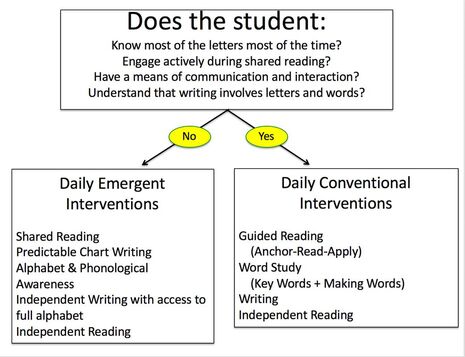An Easy Assessment You Can Do
All children (and adults for that matter) can learn to read and write better. In order to do so, they need to receive appropriate instruction. Karen Erickson, Director of the Center for Literacy and Disability Studies, designed the easy assessment diagrammed above as a way to determine whether learners would benefit more from emergent or conventional literacy instruction. If the answer to one or more of the questions is, "no," then the individual requires emergent literacy instruction in order to move forward. If the answer to all four is, "yes," then the individual requires conventional literacy instruction in order to move forward.
If, for example, your child has one or more no's, then s/he should NOT be receiving instruction:
More to come expanding on these basic ideas in our blog and resources pages. In the meantime, if you can get a copy of the this article by Karen Erickson from your local university library or your public library's inter-library loan services, it explains the strategies and their rationale.
Don't be put off by "severe disabilities" in the title if you feel your child does not have severe disabilities. The principles and practices remain the same.
If, for example, your child has one or more no's, then s/he should NOT be receiving instruction:
- heavily dependently on wh- questioning;
- designed to build sight word vocabulary, particularly through rote memorization of flashcards and the like; or
More to come expanding on these basic ideas in our blog and resources pages. In the meantime, if you can get a copy of the this article by Karen Erickson from your local university library or your public library's inter-library loan services, it explains the strategies and their rationale.
Don't be put off by "severe disabilities" in the title if you feel your child does not have severe disabilities. The principles and practices remain the same.

